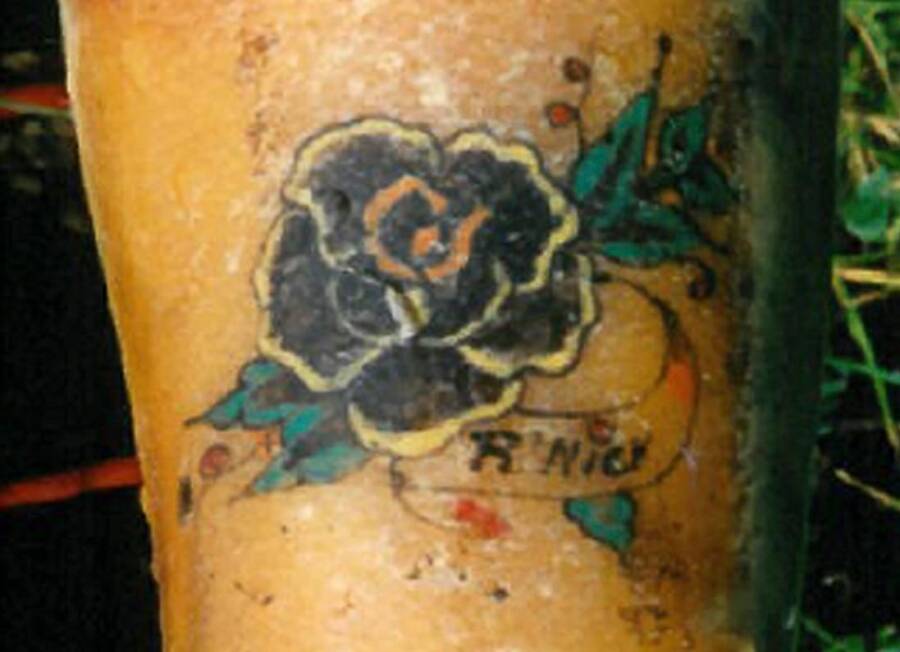Rita Roberts was identified thanks to Operation Identify Me, an international police effort that seeks to identify 22 women who were murdered in Belgium, the Netherlands, and Germany over the past 50 years.

Antwerp Public Prosecutor’s OfficeRita Roberts was identified thanks to a distinctive tattoo on her arm.
On June 3, 1992, a woman’s body was found pushed against a river grate in Antwerp. She had been violently killed, but police couldn’t establish her identity or the identity of her killer. Now, at least one mystery has been solved. After 31 years, she’s been identified as Rita Roberts.
“The news was shocking and heartbreaking,” Roberts’ family said in a statement reported by The New York Times. “Our passionate, loving and free-spirited sister was cruelly taken away. There are no words to truly express the grief we felt at that time, and still feel today.”
According to the BBC, Roberts moved to Antwerp from Cardiff in February 1992 and last communicated with her family when she sent a postcard in May. That June, she was discovered dead against a river grate in Antwerp’s Groot Schijn River. Since Belgian authorities couldn’t identify her, she was nicknamed the “woman with the flower tattoo” because of a distinctive tattoo on her arm of a flower with “R’Nick” written underneath.

Antwerp Public Prosecutor’s OfficeRita Roberts was identified thanks to her distinctive flower tattoo with “R’Nick” written beneath it.
For three decades, Roberts’ identity eluded authorities. But in May 2023, Belgian, Dutch, and German police, along with Interpol, launched Operation Identify Me. They hoped to identify 22 women like Roberts who had been murdered in Belgium, the Netherlands, and Germany over the past 50 years by sharing details about the crime scene and the victims’ appearance that are not usually made public.
“We’ve got to remember that these victims, these women, they’ve become victims twice,” Susan Hitchin, coordinator of Interpol’s DNA unit, said earlier this year, according to The New York Times. “They’ve been murdered and then also their identity has been taken from them.”
When it came to the “woman with the flower tattoo,” Operation Identify Me was extremely effective. The same month it was launched, one of Roberts’ family members spotted her distinctive tattoo in a BBC News article.
“A member of Rita’s family [saw] the Identify Me appeal through the BBC and suddenly realized there may be an opportunity that a lost member of their family had actually come to harm,” Stephen Kavanagh, Interpol’s head of police services, explained to the BBC.
He added: “There’s a terrible contradiction here — we’re proud that we’ve been able to work with member countries, we’re proud that we’ve been able to identify this poor woman, Rita, but we’re also devastated for the family because they’ve lost a loved one through brutal circumstances.”
Operation Identify Me is looking to identify the 21 other women who, like Roberts, have been given temporary nicknames like “the woman in the well,” “the woman with the flower skirt,” and “the woman with the artificial nails.” The BBC reports that they include a woman whose body was found in a trash can floating in a river outside Amsterdam in 1999 and a woman whose body was found bound with string and wrapped in a carpet in Germany in 2002.

InterpolOperation Identify Me seeks to identify 21 other women in addition to Roberts who were found murdered in Belgium, the Netherlands, and Germany over the past 50 years.
“Each of these women were individuals, with families, with friends, with partners, with ambitions. And they’ve all come to harm in brutal circumstances,” Kavanagh told the BBC. “We as global law enforcement have got an opportunity now to try and identify them… and bring closure.
In Roberts’ case, Belgian authorities are encouraging anyone who knows anything about her death to come forward. Pertinent information can be submitted through a form on Interpol’s website.
While Interpol works on bringing her killer to justice, Rita Roberts’ family is focused on remembering the person they knew, loved, and lost.
Rita, they said, was “a beautiful person who adored traveling. She loved her family… and always wanted to have a family of her own. She had the ability to light up a room, and wherever she went, she was the life and soul of the party. We hope that wherever she is now, she is at peace.”
After reading about the identification of Rita Roberts 31 years after she was murdered in Belgium, see how New Jersey’s “Princess Doe” was identified 40 years after her brutal murder. Or, see how authorities in Florida were able to identify a woman known only as “Trunk Lady” 53 years after her murder.





